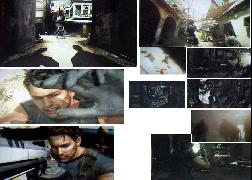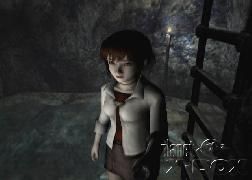I’ve been thinking about the nature of challenge in horror games and games in general lately. It seems to me that there are two basic types of challenges:
- The player is challenged to figure out what he needs to do next, and
- The player knows what to do, but is challenged by actually doing it.
Let me provide a few examples. Myst is a game that is almost entirely driven by what I’ll call Type 1 challenges. You are thrown into an environment with a lot of interactive components and you have to figure out what to do. There’s a bit of Type 2 in there as well, because eventually you figure out what your long-term goals are, but most moment-to-moment challenges are in the form of “what do I do next?”
Devil May Cry is a game that is almost entirely Type 2. You’ve got moves to perform, you’ve got a single exit from most rooms, and all you have to do is beat the crap out of everything between you and the next exit. Of course, “beat the crap out of everything” is a Type 2 challenge because the enemies fight back. In this case your goal is clear but actually reaching that goal requires deft manipulation of the controller, use of combos and powerups, and exploitation of each opponent’s weaknesses, etc.
I’ve chosen Myst and Devil May Cry for a reason. I think you that if you categorized all games into “mainly Type 1” and “mainly Type 2” categories, you’d find that most Type 1 games are PC-based, while most Type 2 games are console-based. Consider the platforming genre (Super Mario, Jak & Daxter, etc): this genre is almost entirely based on mechanical challenges (timing jumps correctly, that sort of thing), so it’s heavily into Type 2 challenges. Same goes for racing games, music games, shooters, beat-em-ups, etc. On the other hand, Type 1 challenges are often employed in games where the actual performing of actions is not particularly difficult. Think of the Adventure genre (The Secret of Monkey Island, Syberia, etc): in these games, actually performing actions is almost automatic (click “apply”, then click on the crowbar, then click on the door… the character cracks open the lock, etc). The challenge of these types of games is deciding what actions are possible rather than which are appropriate.
Maybe this seems like an artificial division, but I think it is valid. It occurred to me that the web game not pron (it’s really not) is an excellent example of these two types of challenges. Each page in the game is a riddle, and you must often decipher a name and password or change the URL in a specific way to proceed to the next page. The riddles are very hard, but even after they are deciphered the game requires you to do some work before you can progress.
[SPOILER ALERT – I’m about to describe the solution to two early riddles in not pron. If you don’t want to read it, skip to the next paragraph]
Early on in the game, you are presented with a picture of a candy wrapper. There are clues in the source file, but the real riddle is deciphering the URL, which is a Type 1 challenge. Once the URL has been deciphered, you realize that to progress you’ll need to name the candy. This is an impossible challenge if you’ve never seen the candy before, but even if you think you recognize it some google searching will be required. This is a Type 2 challenge: the goal is clear but work is required to progress. In another page, you must first decipher that the background music is meaningful (Type 1) then record it, speed it up, and listen to the words that are spoken (Type 2) in order to learn the password to the next riddle.
[/SPOILER]
The problem with not pron is that it is not very fun. At least, I didn’t really enjoy it very much. I don’t mind hard Type 1 or Type 2 challenges, but when they are mixed together the results can be very frustrating. In not pron you are constantly asked to solve a difficult Type 1 challenge, but there’s no reward and no progression until you also solve a related Type 2 challenge. The result, at least for me, was annoyance because I would routinely decipher the riddle of the page and just be too lazy to actually carry out the asinine work that actual progression requires. I’m probably also bitter because in solving one of the riddles required me to download some software that installed loads of spyware and adware on my machine… and that is where I draw the line.
Ok, so right, this is a horror game site. Well, let’s talk about Resident Evil a bit. RE is a mix of Type 1 and Type 2 challenges, and it’s expertly done. First and foremost, we’ve got challenges that involve traversal of the mansion. We need to find keys, unlock doors, solve puzzles, and collect items. This is almost always a Type 1 challenge, because we’re looking for the next set of interactive elements that will help us progress. At the same time, we’ve constantly got to deal with the zombies. Killing or avoiding the zombies while maintaining scarce health and ammo is a Type 2 challenge: we know what we need to do but the actual action is difficult. The balance between these two types of challenges is key, and the best Resident Evil games give you both types of challenges in equal amounts, often staged in such a way that you never feel overwhelmed by the puzzles or the combat. I personally think that Code Veronica is Capcom’s the best example of this. Of course, some people who are expecting all Type 1 or all Type 2 challenges are put off by Resident Evil, as I was put off by not pron.
This is a long post. Thanks for reading.

